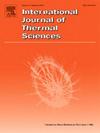Hydrogen diffusion and deflagration characteristics in a closed battery compartment: experimental and numerical simulation investigation
IF 4.9
2区 工程技术
Q1 ENGINEERING, MECHANICAL
International Journal of Thermal Sciences
Pub Date : 2025-04-14
DOI:10.1016/j.ijthermalsci.2025.109920
引用次数: 0
Abstract
The hydrogen diffusion and deflagration characteristics in different ignition positions in a closed battery compartment are systematically researched with experimental and numerical simulation methods, analyzing the hydrogen deflagration flame propagation process, flame propagation velocity, deflagration overpressure, and deflagration temperature. The results show that the maximum concentration gradient between the compartment top and compartment bottom is 4.9%. A nearly spherical flame is first formed after ignition, and the fireball expansion process is restricted by the compartment wall surface and gradually deformed to form a finger-shaped flame. The flame propagation velocity increases with time. And the flame front position increases slowly and then rapidly. In addition, the flame propagates upward from the bottom slightly faster than the flame propagates downward. The deflagration overpressure in ignition position S2 (the top corner of the compartment) is higher compared to that in ignition position S1 (the top center of the compartment), which is nearly 476 KPa. The rise to deflagration peak overpressure is faster when the ignition position is at the compartment top than that at the compartment bottom. In addition, the ignition position on the closed space side (ignition position S2∼S4) is more dangerous.
密闭电池仓内氢气扩散与爆燃特性:实验与数值模拟研究
采用实验和数值模拟相结合的方法,系统研究了密闭电池仓内不同点火位置氢气的扩散和爆燃特性,分析了氢气爆燃火焰传播过程、火焰传播速度、爆燃超压和爆燃温度。研究结果表明,室顶与室底之间的最大浓度梯度为4.9%。点火后首先形成近球形火焰,火球膨胀过程受室壁表面限制,逐渐变形形成指状火焰。火焰传播速度随时间增加而增加。火焰锋面位置先增大后增大。此外,火焰从底部向上传播的速度略快于火焰向下传播的速度。点火位置S2(舱顶角)的爆燃超压高于点火位置S1(舱顶中心),接近476 KPa。点火位置在舱顶时,爆燃峰值超压的上升速度比在舱底时快。此外,封闭空间侧的点火位置(点火位置S2 ~ S4)更危险。
本文章由计算机程序翻译,如有差异,请以英文原文为准。
求助全文
约1分钟内获得全文
求助全文
来源期刊

International Journal of Thermal Sciences
工程技术-工程:机械
CiteScore
8.10
自引率
11.10%
发文量
531
审稿时长
55 days
期刊介绍:
The International Journal of Thermal Sciences is a journal devoted to the publication of fundamental studies on the physics of transfer processes in general, with an emphasis on thermal aspects and also applied research on various processes, energy systems and the environment. Articles are published in English and French, and are subject to peer review.
The fundamental subjects considered within the scope of the journal are:
* Heat and relevant mass transfer at all scales (nano, micro and macro) and in all types of material (heterogeneous, composites, biological,...) and fluid flow
* Forced, natural or mixed convection in reactive or non-reactive media
* Single or multi–phase fluid flow with or without phase change
* Near–and far–field radiative heat transfer
* Combined modes of heat transfer in complex systems (for example, plasmas, biological, geological,...)
* Multiscale modelling
The applied research topics include:
* Heat exchangers, heat pipes, cooling processes
* Transport phenomena taking place in industrial processes (chemical, food and agricultural, metallurgical, space and aeronautical, automobile industries)
* Nano–and micro–technology for energy, space, biosystems and devices
* Heat transport analysis in advanced systems
* Impact of energy–related processes on environment, and emerging energy systems
The study of thermophysical properties of materials and fluids, thermal measurement techniques, inverse methods, and the developments of experimental methods are within the scope of the International Journal of Thermal Sciences which also covers the modelling, and numerical methods applied to thermal transfer.
 求助内容:
求助内容: 应助结果提醒方式:
应助结果提醒方式:


